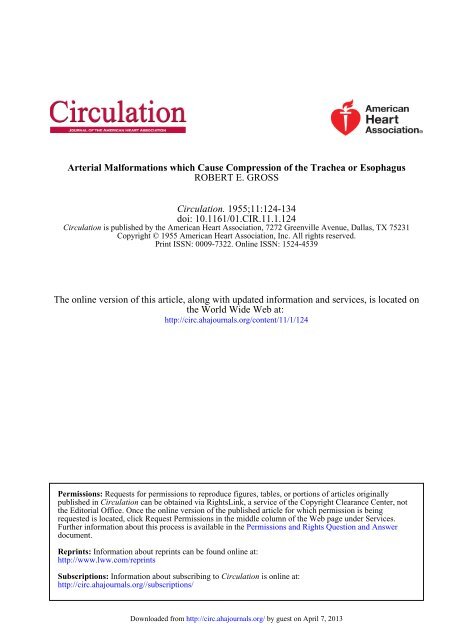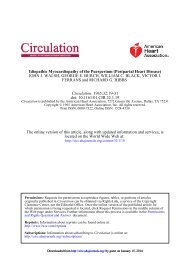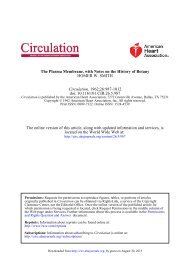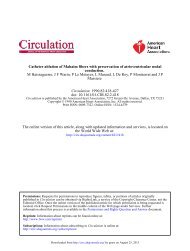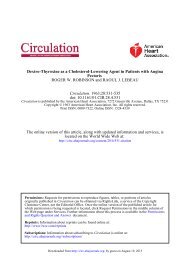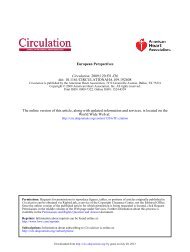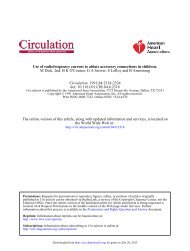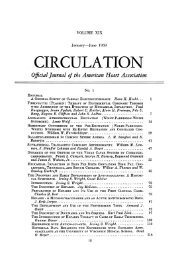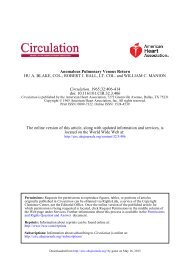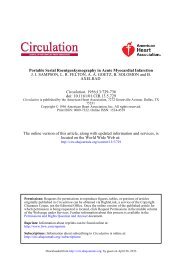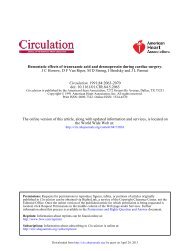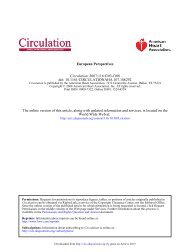Compression of the Trachea or Esophagus - Circulation
Compression of the Trachea or Esophagus - Circulation
Compression of the Trachea or Esophagus - Circulation
You also want an ePaper? Increase the reach of your titles
YUMPU automatically turns print PDFs into web optimized ePapers that Google loves.
Arterial Malf<strong>or</strong>mations which Cause <strong>Compression</strong> <strong>of</strong> <strong>the</strong> <strong>Trachea</strong> <strong>or</strong> <strong>Esophagus</strong><br />
ROBERT E. GROSS<br />
<strong>Circulation</strong>. 1955;11:124-134<br />
doi: 10.1161/01.CIR.11.1.124<br />
<strong>Circulation</strong> is published by <strong>the</strong> American Heart Association, 7272 Greenville Avenue, Dallas, TX 75231<br />
Copyright © 1955 American Heart Association, Inc. All rights reserved.<br />
Print ISSN: 0009-7322. Online ISSN: 1524-4539<br />
The online version <strong>of</strong> this article, along with updated inf<strong>or</strong>mation and services, is located on<br />
<strong>the</strong> W<strong>or</strong>ld Wide Web at:<br />
http://circ.ahajournals.<strong>or</strong>g/content/11/1/124<br />
Permissions: Requests f<strong>or</strong> permissions to reproduce figures, tables, <strong>or</strong> p<strong>or</strong>tions <strong>of</strong> articles <strong>or</strong>iginally<br />
published in <strong>Circulation</strong> can be obtained via RightsLink, a service <strong>of</strong> <strong>the</strong> Copyright Clearance Center, not<br />
<strong>the</strong> Edit<strong>or</strong>ial Office. Once <strong>the</strong> online version <strong>of</strong> <strong>the</strong> published article f<strong>or</strong> which permission is being<br />
requested is located, click Request Permissions in <strong>the</strong> middle column <strong>of</strong> <strong>the</strong> Web page under Services.<br />
Fur<strong>the</strong>r inf<strong>or</strong>mation about this process is available in <strong>the</strong> Permissions and Rights Question and Answer<br />
document.<br />
Reprints: Inf<strong>or</strong>mation about reprints can be found online at:<br />
http://www.lww.com/reprints<br />
Subscriptions: Inf<strong>or</strong>mation about subscribing to <strong>Circulation</strong> is online at:<br />
http://circ.ahajournals.<strong>or</strong>g//subscriptions/<br />
Downloaded from<br />
http://circ.ahajournals.<strong>or</strong>g/ by guest on April 7, 2013
CLINICAL PROGRESS<br />
Edit<strong>or</strong>: HERRMAN L. BLUMGART, M.D.<br />
Associate Edit<strong>or</strong>: A. STONE FREEDBERG, M.D.<br />
Arterial Malf<strong>or</strong>mations which Cause<br />
<strong>Compression</strong> <strong>of</strong> <strong>the</strong> <strong>Trachea</strong><br />
<strong>or</strong> <strong>Esophagus</strong><br />
By IROBERT E. GROss, M.D.<br />
HERE are many vascular malf<strong>or</strong>mations<br />
in <strong>the</strong> superi<strong>or</strong> mediastinum which have<br />
little <strong>or</strong> no clinical significance, but<br />
some arterial anomalies in this region assume<br />
imp<strong>or</strong>tance because an abn<strong>or</strong>mal <strong>or</strong> a displaced<br />
vessel can compress <strong>the</strong> trachea <strong>or</strong> <strong>the</strong> esophagus<br />
(<strong>or</strong> both) and partly obstruct <strong>the</strong>se vital<br />
passages. Since surgical methods are now<br />
available f<strong>or</strong> th<strong>or</strong>acic expl<strong>or</strong>ation <strong>of</strong> even <strong>the</strong><br />
youngest subjects, it is imp<strong>or</strong>tant to recognize<br />
those malf<strong>or</strong>mations which threaten health <strong>or</strong><br />
life; certain <strong>of</strong> <strong>the</strong>se can now be brought under<br />
surgical attack, thus aff<strong>or</strong>ding relief <strong>of</strong> <strong>the</strong><br />
esophageal <strong>or</strong> tracheal obstruction.<br />
Arterial derangements within <strong>the</strong> chest are<br />
common, canl be complex, and can assume many<br />
f<strong>or</strong>ms. These facts are confirmed by a very<br />
extensive literature. A presentation <strong>of</strong> monographic<br />
size would be necessary to list and<br />
describe all <strong>of</strong> <strong>the</strong> anomalies which have been<br />
encountered. It is intended here to deal only<br />
with those, which so far have been found at <strong>the</strong><br />
operating table when attempting to relieve an<br />
existing tracheal <strong>or</strong> esophageal compression.<br />
The following sections are based on <strong>the</strong> study<br />
and surgical care <strong>of</strong> 70 babies and children<br />
with such vascular anomalies. Occasionally,<br />
one <strong>of</strong> <strong>the</strong>se vascular malf<strong>or</strong>mations might<br />
come to light in an adult, but almost certainly<br />
<strong>the</strong> vast maj<strong>or</strong>ity <strong>of</strong> malf<strong>or</strong>mations, which are<br />
serious enough to cause imp<strong>or</strong>tant troubles,<br />
will come to <strong>the</strong> attention <strong>of</strong> a clinician <strong>or</strong> a<br />
From <strong>the</strong> Surgical Service <strong>of</strong> The Children's Hospital<br />
and <strong>the</strong> Department <strong>of</strong> Surgery <strong>of</strong> <strong>the</strong> Harvard<br />
Medical School.<br />
124<br />
surgeon in <strong>the</strong> early years <strong>of</strong> life, as was <strong>the</strong><br />
experience in <strong>the</strong> series <strong>of</strong> cases described here.<br />
The arterial malf<strong>or</strong>mations f<strong>or</strong> which surgery<br />
has some <strong>the</strong>rapeutic value include double<br />
a<strong>or</strong>tic arch, right a<strong>or</strong>tic arch with a left ligamentumrn<br />
arteriosum, anomalous innominate artery~<br />
anomalous left common carotid artery, and<br />
aberrant right subclavian artery.<br />
DOUBLE AORTIC ARCH<br />
Pathologic Anatomy. The fundamental pathologic<br />
change is concerned with <strong>the</strong> fact that <strong>the</strong><br />
ascending a<strong>or</strong>ta bifurcates into two branches,<br />
one passes in front <strong>of</strong> and to <strong>the</strong> left <strong>of</strong> <strong>the</strong><br />
trachea, while <strong>the</strong> o<strong>the</strong>r progresses to <strong>the</strong> right<br />
<strong>of</strong> <strong>the</strong> trachea and esophagus; both limbs <strong>the</strong>n<br />
join to f<strong>or</strong>m a descending a<strong>or</strong>ta (figs. 1 and 2).<br />
In <strong>the</strong> maj<strong>or</strong>ity <strong>of</strong> cases, <strong>the</strong> left (anteri<strong>or</strong>) arch<br />
is <strong>the</strong> smaller <strong>of</strong> <strong>the</strong> two; in a min<strong>or</strong>ity, <strong>the</strong><br />
right (posteri<strong>or</strong>) arch is <strong>the</strong> smaller ill size. The<br />
descending a<strong>or</strong>ta is generally on <strong>the</strong> left side<br />
<strong>of</strong> <strong>the</strong> spinal column, but in an occasional case<br />
it is to <strong>the</strong> right <strong>of</strong> <strong>the</strong> midline (fig. 3). The<br />
space between <strong>the</strong> two a<strong>or</strong>tic arches is insufficient<br />
f<strong>or</strong> accommodation <strong>of</strong> a trachea and<br />
esophagus <strong>of</strong> n<strong>or</strong>mal size. Theref<strong>or</strong>e, both <strong>of</strong><br />
<strong>the</strong>se structures become compressed inl <strong>the</strong><br />
crowded region between <strong>the</strong> two a<strong>or</strong>tic segments.<br />
Clinical picture. In rare cases, <strong>the</strong> space provided<br />
between <strong>the</strong> two a<strong>or</strong>tic arch limbs is<br />
relatively large; <strong>the</strong> encircled trachea and<br />
esophagus have a fair amount <strong>of</strong> room and<br />
<strong>the</strong>re is little <strong>or</strong> no attendant difficulty from<br />
interference with <strong>the</strong> functions <strong>of</strong> <strong>the</strong>se two<br />
pathways. However, most subjects with a<br />
Downloaded from<br />
http://circ.ahajournals.<strong>or</strong>g/ by guest on April 7, 2013<br />
<strong>Circulation</strong>, Volume XI, January, 1955
COMPRESSION OF TRACHEA OR ESOPHAGUS<br />
FIG. 1. Double a<strong>or</strong>tic arch producing compression <strong>of</strong> <strong>the</strong> trachea and esophagus. Left. Preoperative<br />
state. There is a small anteri<strong>or</strong> arch and a large posteri<strong>or</strong> limb, which join and f<strong>or</strong>m <strong>the</strong> descending<br />
a<strong>or</strong>ta. Right. Surgical <strong>the</strong>rapy by dividing <strong>the</strong> ligamentum arteriosum and also <strong>the</strong> anteri<strong>or</strong> arch.<br />
The left common carotid artery is tacked f<strong>or</strong>ward to <strong>the</strong> sternum, thus keeping it from pressing on<br />
<strong>the</strong> trachea. These various steps give sufficient room f<strong>or</strong> <strong>the</strong> trachea and <strong>the</strong> esophagus to bulge to<br />
<strong>the</strong> patient's left and be relieved <strong>of</strong> constriction.<br />
double a<strong>or</strong>tic arch have very little room between<br />
<strong>the</strong> two arterial limbs, so that <strong>the</strong><br />
esophagus and particularly, <strong>the</strong> trachea, are<br />
greatly compressed. While a double a<strong>or</strong>tic<br />
arch is compatible with a long life and relatively<br />
min<strong>or</strong> symptoms, <strong>the</strong> anomaly is usually<br />
a serious one and has <strong>of</strong>ten led to fatality within<br />
<strong>the</strong> first year <strong>or</strong> two <strong>of</strong> life; <strong>the</strong> marked tracheal<br />
obstruction has led to superimposed pulmonary<br />
infection which has overwhelmed many <strong>of</strong><br />
<strong>the</strong>se babies.<br />
Most human subjects with a double a<strong>or</strong>tic<br />
arch have sufficient symptoms to come to <strong>the</strong><br />
attention <strong>of</strong> a physician during infancy. There<br />
may be mild <strong>or</strong> moderate hesitation in swallow-<br />
125<br />
ing. Of greater significance are <strong>the</strong> alarming<br />
symptoms which come from tracheal narrowing.<br />
The respirat<strong>or</strong>y rate is generally increased. The<br />
baby struggles to obtain an adequate exchange<br />
<strong>of</strong> air, an eff<strong>or</strong>t which <strong>of</strong>ten requires <strong>the</strong> use <strong>of</strong><br />
<strong>the</strong> access<strong>or</strong>y muscles <strong>of</strong> respiration. During<br />
inspiration <strong>the</strong>re may be intercostal and suprasternal<br />
retraction. A loud wheeze can be heard<br />
by stethoscopic auscultation, but usually <strong>the</strong><br />
noise is great enough to be heard with <strong>the</strong> unaided<br />
ear many feet <strong>or</strong> yards away. There is<br />
apt to be a "crowing" type <strong>of</strong> breathing, with<br />
a marked inspirat<strong>or</strong>y and expirat<strong>or</strong>y strid<strong>or</strong>.<br />
Respirat<strong>or</strong>y distress is very apt to be made<br />
w<strong>or</strong>se during <strong>or</strong> immediately after <strong>the</strong> swallow-<br />
Downloaded from<br />
http://circ.ahajournals.<strong>or</strong>g/ by guest on April 7, 2013
126<br />
CLINICAL IPROGRESS<br />
FIG. 2. Double a<strong>or</strong>tic arch with large anteri<strong>or</strong> limb and a smaller posteri<strong>or</strong> limb, producing compression<br />
<strong>of</strong> <strong>the</strong> trachea and esophagus. Above. The two drawings show <strong>the</strong> anteri<strong>or</strong> and posteri<strong>or</strong><br />
views <strong>of</strong> <strong>the</strong> anomaly. Below. Treatment <strong>of</strong> <strong>the</strong> condition by division <strong>of</strong> <strong>the</strong> small posteri<strong>or</strong> arch,<br />
thus returning all structures to n<strong>or</strong>mal.<br />
ing <strong>of</strong> milk <strong>or</strong> food. Ill severe cases, symptoms<br />
are serious enough to demand oxygell <strong>the</strong>rapy.<br />
These babies are prone to lie with <strong>the</strong>ir heads<br />
in hyperextension, a position which tends to<br />
attenuate <strong>the</strong> trachea and push away from its<br />
anteri<strong>or</strong> surface any structure which is impinging<br />
upon it. If <strong>the</strong> examiner f<strong>or</strong>ceably<br />
straightens <strong>the</strong> head, <strong>or</strong> flexes it toward <strong>the</strong><br />
sternum, <strong>the</strong> exchange <strong>of</strong> air is reduced <strong>or</strong> call<br />
even be completely shut <strong>of</strong>f, though <strong>the</strong> respirat<strong>or</strong>y<br />
movements <strong>of</strong> <strong>the</strong> th<strong>or</strong>ax continue.<br />
Roentgenographic Findings. Roentgenograms<br />
<strong>of</strong> <strong>the</strong> chest may show some pneumonitis, if<br />
<strong>the</strong>y happen to be taken at a time when <strong>the</strong>re<br />
is superimposed lung infection. Films takenii<br />
during inspiration may indicate po<strong>or</strong> <strong>or</strong> irregular<br />
aeration <strong>of</strong> <strong>the</strong> lungs, whereas during<br />
expiration <strong>the</strong>re is apt to be an appearance <strong>of</strong><br />
hyperaeration. Lateral films, if made at <strong>the</strong><br />
c<strong>or</strong>rect exposure, can frequently outline <strong>the</strong><br />
trachea by <strong>the</strong> air which it contains. Thus,<br />
without <strong>the</strong> use <strong>of</strong> a contrast medium, a fair<br />
appraisal can be made <strong>of</strong> <strong>the</strong> anteroposteri<strong>or</strong><br />
diameter <strong>of</strong> <strong>the</strong> trachea. While its upper p<strong>or</strong>tion<br />
is <strong>of</strong> n<strong>or</strong>mal caliber, <strong>the</strong> lower part has a<br />
markedly reduced lumen and <strong>the</strong> structure is<br />
apt to be displaced f<strong>or</strong>ward. A swallow <strong>of</strong><br />
barium shows indentation <strong>of</strong> <strong>the</strong> posteri<strong>or</strong> wall<br />
<strong>of</strong> <strong>the</strong> esophagus at <strong>the</strong> level <strong>of</strong> <strong>the</strong> third <strong>or</strong><br />
fourth th<strong>or</strong>acic vertebra, this defect being<br />
niearly a h<strong>or</strong>izontal one, and occurring at a<br />
level close to that where <strong>the</strong> tracheal compression<br />
is found. If fur<strong>the</strong>r evidence regarding <strong>the</strong><br />
status <strong>of</strong> <strong>the</strong> trachea appears to be desirable,<br />
Downloaded from<br />
http://circ.ahajournals.<strong>or</strong>g/ by guest on April 7, 2013
COMPRESSION OF TRACHEA OR ESOPHAGUS<br />
FIG. 3. Double a<strong>or</strong>tic arch with <strong>the</strong> a<strong>or</strong>ta descending on <strong>the</strong> right, constricting <strong>the</strong> trachea and<br />
esophagus. Above. Anteri<strong>or</strong> and posteri<strong>or</strong> drawings <strong>of</strong> <strong>the</strong> anomaly. The left arch is <strong>the</strong> smaller <strong>of</strong><br />
<strong>the</strong> two. The ligamentum arteriosum between <strong>the</strong> pulmonary artery and <strong>the</strong> a<strong>or</strong>ta also f<strong>or</strong>ms a<br />
part <strong>of</strong> <strong>the</strong> constricting mechanism. Below. Method <strong>of</strong> surgical <strong>the</strong>rapy. The smaller left arch has<br />
been divided and cut away from <strong>the</strong> descending a<strong>or</strong>ta; <strong>the</strong> left subclavian artery has been divided at<br />
its <strong>or</strong>igin. The left common carotid artery has been tacked f<strong>or</strong>ward to keep it <strong>of</strong>f <strong>of</strong> <strong>the</strong> trachea. The<br />
ligamentum arteriosum has also been cut.<br />
Downloaded from<br />
http://circ.ahajournals.<strong>or</strong>g/ by guest on April 7, 2013<br />
127
128<br />
this can be gained by lipiodol injection and delineation;<br />
f<strong>or</strong> children under a year <strong>of</strong> age this<br />
can generally be done without anes<strong>the</strong>sia, but<br />
f<strong>or</strong> older subjects it is best carried out under<br />
some f<strong>or</strong>m <strong>of</strong> general narcosis. Anteroposteri<strong>or</strong><br />
films show a definite compression <strong>of</strong> both sides<br />
<strong>of</strong> <strong>the</strong> trachea in its lower third; lateral views<br />
shows a constriction which is striking. This<br />
narrowing is at a level approximating that<br />
where <strong>the</strong> defect was found on <strong>the</strong> posteri<strong>or</strong><br />
wall <strong>of</strong> <strong>the</strong> esophagus. The combination <strong>of</strong> a<br />
posteri<strong>or</strong> esophageal compression and an anteri<strong>or</strong><br />
tracheal defect (when found in <strong>the</strong><br />
absence <strong>of</strong> a demonstrable mediastinal mass) is<br />
almost certain pro<strong>of</strong> <strong>of</strong> some type <strong>of</strong> an encircling<br />
"vascular ring". The size <strong>of</strong> <strong>the</strong><br />
posteri<strong>or</strong> esophageal indentation is usually a<br />
fair indication <strong>of</strong> whe<strong>the</strong>r <strong>the</strong> posteri<strong>or</strong> arch is<br />
<strong>the</strong> larger <strong>or</strong> <strong>the</strong> smaller <strong>of</strong> <strong>the</strong> two.<br />
Surgical <strong>the</strong>rapy. Surgery has much to <strong>of</strong>fer<br />
<strong>the</strong>se patients, because division <strong>of</strong> <strong>the</strong> smaller<br />
arch provides m<strong>or</strong>e room f<strong>or</strong> <strong>the</strong> esophagus and<br />
particularly f<strong>or</strong> <strong>the</strong> trachea. Without discussing<br />
<strong>the</strong> details <strong>of</strong> operative steps, <strong>the</strong> surgical<br />
solution <strong>of</strong> <strong>the</strong> problem is indicated in figs.<br />
1, 2, and 3. Most commonly, it is <strong>the</strong> anteri<strong>or</strong><br />
arch which is <strong>the</strong> smaller <strong>of</strong> <strong>the</strong> two and thus<br />
is <strong>the</strong> one which must be severed. In a min<strong>or</strong>ity<br />
<strong>of</strong> cases, <strong>the</strong> posteri<strong>or</strong> arch is <strong>the</strong> smaller and is<br />
<strong>the</strong> one which must be divided. In some cases<br />
<strong>the</strong> pulmonary artery has been held in a retrodisplaced<br />
position by virtue <strong>of</strong> its attachment<br />
to <strong>the</strong> a<strong>or</strong>ta through <strong>the</strong> ligamentum arteriosum.<br />
This ligament should be divided, to<br />
allow <strong>the</strong> pulmonary artery to fall f<strong>or</strong>ward.<br />
While this additional step seems to have little<br />
value f<strong>or</strong> some patients, it is certainly an imp<strong>or</strong>tant<br />
one f<strong>or</strong> o<strong>the</strong>rs.<br />
Results qf <strong>the</strong>rapy. Of <strong>the</strong> 26 patients with<br />
double a<strong>or</strong>tic arches who have come to operation,<br />
16 had <strong>the</strong> a<strong>or</strong>ta descending on <strong>the</strong> left<br />
and 10 on <strong>the</strong> right. Of <strong>the</strong> 16 with a left<br />
descending a<strong>or</strong>ta, <strong>the</strong>re were 11 in whom <strong>the</strong><br />
left (anteri<strong>or</strong>) arch was <strong>the</strong> smaller <strong>of</strong> <strong>the</strong> two<br />
and was acc<strong>or</strong>dingly divided, and <strong>the</strong>re were<br />
five in whom <strong>the</strong> right (posteri<strong>or</strong>) limb was <strong>the</strong><br />
smaller one and was <strong>the</strong>ref<strong>or</strong>e sectioned. Of <strong>the</strong><br />
10 patients who had double arches and a right<br />
descending a<strong>or</strong>ta, it was always <strong>the</strong> left (posteri<strong>or</strong>)<br />
one which was severed. These 26 sub-<br />
CLINICAL PROGRESS<br />
Downloaded from<br />
http://circ.ahajournals.<strong>or</strong>g/ by guest on April 7, 2013<br />
jects ranged in age from one month to three<br />
years. There have been five deaths; two from<br />
hem<strong>or</strong>rhage at <strong>the</strong> operating table, one from<br />
cerebral edema <strong>the</strong> day following surgery (<strong>the</strong><br />
child had been dangerously ill and in an oxygen<br />
tent f<strong>or</strong> several months pri<strong>or</strong> to surgical<br />
<strong>the</strong>rapy), and two from pneumonia 3 and 10<br />
days after operation. The 21 surviving patients<br />
have been followed f<strong>or</strong> varying lengths <strong>of</strong> time,<br />
up to nine years, since operation. They have<br />
had extra<strong>or</strong>dinary relief <strong>of</strong> symptoms. Usually,<br />
a marked improvement in <strong>the</strong> airway has been<br />
noted immediately after operation. In all<br />
instances, <strong>the</strong> exchange <strong>of</strong> air has obviously<br />
been m<strong>or</strong>e free, and <strong>the</strong> subjects have not had<br />
to use <strong>the</strong> access<strong>or</strong>y muscles <strong>of</strong> respiration f<strong>or</strong><br />
<strong>or</strong>dinary activity. Strid<strong>or</strong> has usually vanished,<br />
but in a few instances a trace <strong>of</strong> it remains.<br />
Postoperative tracheograms have usually<br />
shown marked improvement in size <strong>of</strong> <strong>the</strong><br />
tracheal lumen after operation, but generally<br />
some def<strong>or</strong>mity persists in <strong>the</strong> cartilages. It is<br />
reasonable to believe that <strong>the</strong> removal <strong>of</strong> all<br />
external pressure will give <strong>the</strong>se tracheas a<br />
better chance to develop in future years as <strong>the</strong><br />
children progress in body growth.<br />
The overall results postoperatively have<br />
been exceedingly dramatic and have proved<br />
beyond a doubt that an operative attack on this<br />
vascular abn<strong>or</strong>mality has great merit. This<br />
does not imply that all humans with a double<br />
a<strong>or</strong>tic arch should necessarily be operated<br />
upon, because <strong>the</strong>re are doubtlessly a few who<br />
tolerate <strong>the</strong> condition in a reasonably satisfact<strong>or</strong>y<br />
way through a long life. However, it<br />
appears that most infants and young children<br />
with this abn<strong>or</strong>mality are extremely apt to<br />
develop serious <strong>or</strong> even fatal complications at<br />
some subsequent time, and, hence, we feel that<br />
it is generally highly desirable to undertake<br />
surgical c<strong>or</strong>rection <strong>of</strong> <strong>the</strong> vascular anomaly<br />
whenever it is discovered.<br />
RIGHT AORTIC ARCH WITH LEFT<br />
LIGAMENTUM ARTERIOSUM<br />
Pathologic anatomy. The first part <strong>of</strong> <strong>the</strong><br />
ascending a<strong>or</strong>ta lies in a n<strong>or</strong>mal position, but,<br />
instead <strong>of</strong> being directed upward and to <strong>the</strong><br />
left in front <strong>of</strong> <strong>the</strong> trachea, it ascends and passes<br />
to <strong>the</strong> right <strong>of</strong> <strong>the</strong> trachea and <strong>the</strong> esophagus,
COMPRESSION OF TRACHEA OR ESOPHAGUS<br />
FIG. 4. Right a<strong>or</strong>tic arch, with a left ligamentum arteriosum, producing compression <strong>of</strong> <strong>the</strong> trachea<br />
and esophagus. Above. Anteri<strong>or</strong> and posteri<strong>or</strong> views <strong>of</strong> <strong>the</strong> anomaly. Below. Surgical c<strong>or</strong>rection,<br />
by division <strong>of</strong> <strong>the</strong> ligamentum arteriosum and <strong>the</strong> first part <strong>of</strong> <strong>the</strong> left subclavian artery. These<br />
steps allow <strong>the</strong> trachea and esophagus to bulge to <strong>the</strong> left and to <strong>the</strong> rear.<br />
and <strong>the</strong>n continues as a descending a<strong>or</strong>ta which<br />
may lie ei<strong>the</strong>r to <strong>the</strong> left <strong>or</strong> to <strong>the</strong> right <strong>of</strong> <strong>the</strong><br />
vertebral column. A right a<strong>or</strong>tic arch in itself<br />
causes little <strong>or</strong> no disturbance, though at times<br />
it has been known to press on <strong>the</strong> right main<br />
bronchus <strong>or</strong> one <strong>of</strong> its branches and has led to<br />
pathologic changes in <strong>the</strong> lung. If <strong>the</strong> ligamentum<br />
arteriosum, <strong>or</strong> a patent ductus, runs from<br />
129<br />
<strong>the</strong> pulmonary artery to <strong>the</strong> left <strong>of</strong> <strong>the</strong> trachea<br />
and <strong>the</strong> posteri<strong>or</strong> aspect <strong>of</strong> <strong>the</strong> esophagus to<br />
join <strong>the</strong> descending a<strong>or</strong>ta, this completes a<br />
constricting ring which encircles <strong>the</strong> esophagus<br />
and trachea (fig. 4). If this ring is sufficiently<br />
large, <strong>the</strong> functions <strong>of</strong> <strong>the</strong> esophagus and <strong>the</strong><br />
trachea are not altered to any imp<strong>or</strong>tant degree,<br />
but if <strong>the</strong> ligamentum arteriosum is taut, <strong>the</strong><br />
Downloaded from<br />
http://circ.ahajournals.<strong>or</strong>g/ by guest on April 7, 2013
130<br />
space within <strong>the</strong> elncirclilng structures is so<br />
small that <strong>the</strong> compressed esophagus, and<br />
especially <strong>the</strong> trachea, are greatly disturbed.<br />
Clinical picture. With this anomaly, symptoms<br />
can develop quite similar to those which<br />
are produced by a double a<strong>or</strong>tic arch, but<br />
generally are apt not to be quite so severe. As<br />
a rule, <strong>the</strong> onset <strong>of</strong> complaints is delayed until<br />
a bit later in childhood; <strong>the</strong> patients that we<br />
have encountered were on all average a few<br />
years older than those with a double a<strong>or</strong>tic<br />
arch, <strong>the</strong> latter usually being seeni in infancy.<br />
There may be a crowing type <strong>of</strong> respiration,<br />
some intercostal and suprasternal retraction,<br />
possibly recurrent pulmonary infection, and<br />
occasionally even some hesitancy in swallowing.<br />
The respirat<strong>or</strong>y symptoms are generally aggravated<br />
during and following deglutition.<br />
Roentgenographic findings. There may be<br />
evidence <strong>of</strong> pulmonary infection. There is a<br />
prominent shadow (a<strong>or</strong>tic arch) projecting<br />
from <strong>the</strong> right side <strong>of</strong> <strong>the</strong> superi<strong>or</strong> mediastinum.<br />
During inspiration <strong>the</strong>re may be incomplete<br />
aeration <strong>of</strong> <strong>the</strong> lungs, and during expiration<br />
<strong>the</strong>re may be hyperaeration, indicative <strong>of</strong><br />
an obstruction somewhere above <strong>the</strong> carina.<br />
Lateral films <strong>of</strong> <strong>the</strong> chest, if appropriately exposed,<br />
can outline <strong>the</strong> air-filled trachea, showing<br />
<strong>the</strong> upper p<strong>or</strong>tion to be n<strong>or</strong>mal, whereas <strong>the</strong><br />
lower segment is distinctly narrowed. Instillation<br />
<strong>of</strong> lipiodol into <strong>the</strong> trachea gives better<br />
visualization, shows a slight and ra<strong>the</strong>r<br />
elongated indentation <strong>of</strong> <strong>the</strong> right wall <strong>of</strong> <strong>the</strong><br />
trachea, imposed by <strong>the</strong> adjacent a<strong>or</strong>tic arch,<br />
inldentation <strong>of</strong> <strong>the</strong> anteri<strong>or</strong> surface <strong>of</strong> <strong>the</strong><br />
trachea where <strong>the</strong> pulmonary artery is pulled<br />
against it, and a depression on <strong>the</strong> left side <strong>of</strong><br />
<strong>the</strong> trachea from <strong>the</strong> ligamentum arteriosum.<br />
With a swallow <strong>of</strong> barium, one finds, at <strong>the</strong><br />
same level as <strong>the</strong> tracheal defects were observed,<br />
that <strong>the</strong> esophagus has a narrow but<br />
very deep constriction in its left-lateral and<br />
posteri<strong>or</strong> surfaces. Above this posteri<strong>or</strong> notching<br />
<strong>of</strong> <strong>the</strong> esophagus, it is sometimes possible<br />
to identify a separate defect, passing obliquely<br />
upward and to <strong>the</strong> left, which is caused by <strong>the</strong><br />
left subclavian artery which arises from <strong>the</strong><br />
a<strong>or</strong>ta and passes behind <strong>the</strong> esophagus to reach<br />
<strong>the</strong> left apex <strong>of</strong> <strong>the</strong> chest. By flu<strong>or</strong>oscopic and<br />
film studies, it is usually possible to recognize<br />
CLINICAL PROGRESS<br />
Downloaded from<br />
http://circ.ahajournals.<strong>or</strong>g/ by guest on April 7, 2013<br />
accurately this combination <strong>of</strong> vascular anomalies,<br />
but in some instances it is almost impossible<br />
to differentiate it from a double a<strong>or</strong>tic<br />
arch which is combined with a right descending<br />
a<strong>or</strong>ta.<br />
Surgical <strong>the</strong>rapy. Treatment <strong>of</strong> this condition<br />
is obviously one <strong>of</strong> alleviation and not <strong>of</strong> cure;<br />
it is impossible to shift <strong>the</strong> a<strong>or</strong>tic arch from its<br />
right-sided bed, but we can divide <strong>the</strong> ligamenltum<br />
arteriosum, which thus breaks <strong>the</strong> constricting<br />
"ring". The ligamentum arteriosum<br />
should also be divided. When <strong>the</strong>se steps are<br />
properly perf<strong>or</strong>med, <strong>the</strong> pulmonary artery falls<br />
f<strong>or</strong>ward into a m<strong>or</strong>e n<strong>or</strong>mal position and sufficient<br />
room is given f<strong>or</strong> <strong>the</strong> esophagus, and particularly<br />
<strong>the</strong> trachea, to drop backward and to<br />
<strong>the</strong> left. Whenever <strong>the</strong> left subclavian artery is<br />
found behind <strong>the</strong> esophagus, it, too, should be<br />
severed.<br />
Results <strong>of</strong> <strong>the</strong>rapy. Eighteen patients with<br />
this anomaly have been operated upon, <strong>the</strong><br />
youngest two months and <strong>the</strong> oldest 12 years<br />
<strong>of</strong> age. There have been no deaths. The result<br />
in all subjects has been striking improvement.<br />
There has always been complete disappearance<br />
<strong>of</strong> any pre-existing dysphagia. There has been<br />
marked alleviation <strong>of</strong> respirat<strong>or</strong>y distress<br />
which all subjects had pri<strong>or</strong> to operationii. In one<br />
<strong>of</strong> <strong>the</strong> older children, repeat tracheograms at<br />
<strong>the</strong> end <strong>of</strong> one year showed only disappointing<br />
growth <strong>of</strong> <strong>the</strong> tracheal rings in <strong>the</strong> involved<br />
area: this case emphasizes <strong>the</strong> desirability <strong>of</strong><br />
carrying out <strong>the</strong>se operations at an earlier time<br />
in life so that removal <strong>of</strong> all external pressure<br />
will give <strong>the</strong> trachea <strong>the</strong> best possible chance to<br />
enlarge during <strong>the</strong> growth period <strong>of</strong> <strong>the</strong> child.<br />
It has long been known that a considerable<br />
number <strong>of</strong> humans possess a right a<strong>or</strong>tic arch,<br />
but have few symptoms <strong>the</strong>refrom. Presumably,<br />
<strong>the</strong>se have had a ligamentum arteriosum<br />
in front <strong>of</strong> <strong>the</strong> trachea <strong>or</strong> else this structure,<br />
even though it passes to <strong>the</strong> left and posteri<strong>or</strong><br />
aspects <strong>of</strong> <strong>the</strong> trachea and esophagus, has been<br />
very long and lax. In such instances operative<br />
intervention is not required. However, it is imp<strong>or</strong>tant<br />
to recognize those occasional individuals<br />
who do have a high degree <strong>of</strong> tracheal<br />
narrowing from one <strong>of</strong> <strong>the</strong> encirclements under<br />
discussion, because it is in this group that<br />
surgical <strong>the</strong>rapy is a procedure <strong>of</strong> great value,<br />
particularly when it is perf<strong>or</strong>med early in life
COMPRESSION OF TRACHEA OR ES()PHAGUS11<br />
V<br />
FIG. 5. <strong>Compression</strong> <strong>of</strong> <strong>the</strong> trachea by an anomalous <strong>or</strong>igin <strong>of</strong> <strong>the</strong> innominate artery (<strong>or</strong> <strong>the</strong> left<br />
common carotid artery) from <strong>the</strong> a<strong>or</strong>tic arch. Left. Drawing showing pressure on anteri<strong>or</strong> surface <strong>of</strong><br />
trachea by an anomalous left common carotid artery. Right. Alleviation <strong>of</strong> <strong>the</strong> tracheal compression<br />
by grasping advential structures <strong>of</strong> <strong>the</strong> <strong>of</strong>fending vessels and drawing <strong>the</strong>m to <strong>the</strong> sternum.<br />
bef<strong>or</strong>e <strong>the</strong> tracheal wall has become permanently<br />
def<strong>or</strong>med.<br />
ANOMALOUS INNOMINATE ARTERY<br />
Pathologic anatomy. The innominate artery<br />
can <strong>or</strong>iginate at a point far<strong>the</strong>r along on <strong>the</strong><br />
arch than is n<strong>or</strong>mal; when it does so, it must<br />
wind around <strong>the</strong> anteri<strong>or</strong> surface <strong>of</strong> <strong>the</strong> trachea<br />
as it courses upward and to <strong>the</strong> right, to reach<br />
<strong>the</strong> right apex <strong>of</strong> <strong>the</strong> chest. If this vessel is large<br />
and taut, it can compress <strong>the</strong> trachea to a<br />
serious degree (fig. 5). While <strong>the</strong> pathologic<br />
anatomy is seemingly only a min<strong>or</strong> variation<br />
from n<strong>or</strong>mal and would appear to be <strong>of</strong> little<br />
consequence, <strong>the</strong> severity <strong>of</strong> symptoms which<br />
can accompany it has been emphasized by<br />
several patients who have been studied and<br />
found to have this anomaly.<br />
Clinical picture. There can be inspirat<strong>or</strong>y and<br />
expirat<strong>or</strong>y crow <strong>of</strong> considerable degree, intercostal<br />
and suprasternal retraction, marked<br />
dyspnea, and even superimposed pneumonitis.<br />
<strong>Trachea</strong>l compression call be sufficiently severe<br />
to require <strong>the</strong> use <strong>of</strong> an oxygen tent. The<br />
head is apt to be held in hyperextension, which<br />
apparently improves <strong>the</strong> exchange <strong>of</strong> air f<strong>or</strong> <strong>the</strong><br />
child. There is no hesitancy in swallowing, n<strong>or</strong><br />
are <strong>the</strong> respirat<strong>or</strong>y symptoms made w<strong>or</strong>se<br />
during feeding.<br />
Roentgenographic findings. By roentgenologic<br />
study, <strong>the</strong> esophagus is entirely n<strong>or</strong>mal. The<br />
131<br />
a<strong>or</strong>tic arch is n<strong>or</strong>mal in size and in position.<br />
Visualization <strong>of</strong> <strong>the</strong> trachea may show little in<br />
<strong>the</strong> anteroposteri<strong>or</strong> view, but lateral projections<br />
indicate a considerable narrowing in<br />
its lower third, <strong>the</strong> indentation appearing<br />
entirely on <strong>the</strong> anteri<strong>or</strong> wall, whereas <strong>the</strong><br />
posteri<strong>or</strong> wall is straight and in n<strong>or</strong>mal alignment.<br />
It may be exceedingly difficult, <strong>or</strong> indeed<br />
impossible, to determine whe<strong>the</strong>r <strong>the</strong> base <strong>of</strong><br />
<strong>the</strong> innominate artery <strong>or</strong> <strong>the</strong> base <strong>of</strong> <strong>the</strong> left<br />
common carotid artery (described in <strong>the</strong> next<br />
section) is at fault, but in some instances <strong>the</strong><br />
obliquity <strong>of</strong> <strong>the</strong> anteri<strong>or</strong> tracheal defect suggests<br />
which <strong>of</strong> <strong>the</strong>se vessels is <strong>the</strong> <strong>of</strong>fending one.<br />
In <strong>the</strong> absence <strong>of</strong> any anteri<strong>or</strong> mediastinal<br />
shadow (such as a cyst <strong>or</strong> neoplasm) a tracheal<br />
defect <strong>of</strong> this s<strong>or</strong>t certainly suggests some abn<strong>or</strong>mal<br />
blood vessel in <strong>the</strong> region as a cause <strong>of</strong><br />
<strong>the</strong> trouble. Any narrowing <strong>of</strong> <strong>the</strong> trachea which<br />
hints <strong>of</strong> <strong>the</strong> presence <strong>of</strong> an abn<strong>or</strong>mal blood<br />
vessel <strong>of</strong> this s<strong>or</strong>t can raise <strong>the</strong> question <strong>of</strong><br />
whe<strong>the</strong>r <strong>the</strong> diminished lumen <strong>of</strong> <strong>the</strong> trachea is<br />
dependent upon incomplete development <strong>of</strong> its<br />
tracheal cartilages. Data on this point can be<br />
ga<strong>the</strong>red from direct tracheoscopy and also by<br />
serial observations made roentgenologically<br />
throughout <strong>the</strong> respirat<strong>or</strong>y cycle. If <strong>the</strong> tracheal<br />
defect is due to some external pressure, <strong>the</strong><br />
narrowing remains relatively constant throughout<br />
<strong>the</strong> respirat<strong>or</strong>y cycle; if <strong>the</strong> narrowing is<br />
due to deficient cartilagenous rings, <strong>the</strong> caliber<br />
Downloaded from<br />
http://circ.ahajournals.<strong>or</strong>g/ by guest on April 7, 2013
132<br />
<strong>of</strong> <strong>the</strong> trachea will increase during inspiration<br />
and decrease during expiration.<br />
Surgical <strong>the</strong>rapy. After dissecting <strong>of</strong>f and discarding<br />
<strong>the</strong> thymus, it is possible to view <strong>the</strong><br />
a<strong>or</strong>tic arch and <strong>the</strong> vessels in question. The<br />
base <strong>of</strong> <strong>the</strong> innominate artery can be seen<br />
wrapped around <strong>the</strong> anteri<strong>or</strong> surface <strong>of</strong> <strong>the</strong><br />
trachea, causing a decided indentation. Because<br />
<strong>of</strong> possible consequent brain damage, <strong>the</strong><br />
<strong>of</strong>fending vessel should not be severed. However,<br />
<strong>the</strong> first part <strong>of</strong> this artery and <strong>the</strong> accompanying<br />
a<strong>or</strong>tic arch can be drawn f<strong>or</strong>ward<br />
by sutures taken through <strong>the</strong>ir adventitias and<br />
<strong>the</strong> surrounding s<strong>of</strong>t tissues and running <strong>the</strong>se<br />
silk sutures f<strong>or</strong>ward through <strong>the</strong> substance <strong>of</strong><br />
<strong>the</strong> sternum. Appropriate tension on <strong>the</strong>se silk<br />
sutures draws <strong>the</strong> vessels f<strong>or</strong>ward and thus<br />
carries <strong>the</strong>m away from <strong>the</strong> trachea, <strong>the</strong>reby<br />
completely relieving <strong>the</strong> preexisting external<br />
pressure (fig. 5). These maneuvers are relatively<br />
easy to perf<strong>or</strong>m.<br />
Results <strong>of</strong> <strong>the</strong>rapy. Nine patients, all under<br />
one year <strong>of</strong> age, have been operated upon;<br />
<strong>the</strong>re have been no deaths. The results <strong>of</strong> <strong>the</strong>se<br />
undertakings have been very gratifying. The<br />
first patient had previously been hospitalized<br />
f<strong>or</strong> four months because <strong>of</strong> severe respirat<strong>or</strong>y<br />
CLINICAL PROGRESS<br />
distress; she was discharged eight days after<br />
operation, completely free <strong>of</strong> symptoms. The<br />
o<strong>the</strong>r patients have likewise been dramatically<br />
relieved <strong>of</strong> <strong>the</strong>ir respirat<strong>or</strong>y complaints.<br />
ANOMALOUS LEFT COMMON CAROTID ARTERY<br />
Pathologic anatomy. This malf<strong>or</strong>mation is<br />
probably very rare. It is somewhat akin to <strong>the</strong><br />
anomalous innominate artery described in <strong>the</strong><br />
last section. The vessel is <strong>of</strong> n<strong>or</strong>mal size and<br />
distribution, but has an <strong>or</strong>igin which permits<br />
it to branch <strong>of</strong>f <strong>of</strong> <strong>the</strong> a<strong>or</strong>tic arch m<strong>or</strong>e to <strong>the</strong><br />
patient's right than is n<strong>or</strong>mal (fig. 6). It must<br />
<strong>the</strong>ref<strong>or</strong>e wind around <strong>the</strong> anteri<strong>or</strong> surface <strong>of</strong><br />
<strong>the</strong> trachea as it courses upward and to <strong>the</strong><br />
left, to reach <strong>the</strong> left apex <strong>of</strong> <strong>the</strong> chest.<br />
Clinical picture. The symptoms produced<br />
will obviously depend upon <strong>the</strong> degree <strong>of</strong> pressure<br />
which is exerted upon <strong>the</strong> front <strong>of</strong> <strong>the</strong><br />
trachea. There may be moderate respirat<strong>or</strong>y<br />
distress, some crowing during respirat<strong>or</strong>y<br />
movements, dyspnea <strong>of</strong> mild to moderate<br />
degree, and possibly bouts <strong>of</strong> pulmonary infection.<br />
There are no disturbances in<br />
swallowing.<br />
Roentgenologic findings. By roentgenographic<br />
examination, <strong>the</strong> findings are quite similar to,<br />
FIG. 6. Aberrant right subclavian artery, producing "dysphagia lus<strong>or</strong>ia" by posteri<strong>or</strong> compression<br />
<strong>of</strong> <strong>the</strong> esophagus. The right subclavian artery, instead <strong>of</strong> arising n<strong>or</strong>mally from <strong>the</strong> innominate<br />
artery, has an abn<strong>or</strong>mal <strong>or</strong>igin from <strong>the</strong> descending a<strong>or</strong>ta, from which it courses upward and to<br />
<strong>the</strong> patient's right to emerge from <strong>the</strong> chest. Left. Drawing <strong>of</strong> <strong>the</strong> malf<strong>or</strong>mation. Right. Treatment<br />
<strong>of</strong> <strong>the</strong> dysphagia by ligation and division <strong>of</strong> <strong>the</strong> aberrant right subclavian artery.<br />
Downloaded from<br />
http://circ.ahajournals.<strong>or</strong>g/ by guest on April 7, 2013
COMPRESSION OF TRACHEA OR ES()OPHAGUS<br />
and <strong>of</strong>ten indistinguishable from those described<br />
in <strong>the</strong> last section f<strong>or</strong> anomalous innominate<br />
artery. The esophagus is n<strong>or</strong>mal by<br />
barium study. The trachea has a posteri<strong>or</strong> wall<br />
which is sharp, distinct, and <strong>of</strong> n<strong>or</strong>mal contour<br />
and position, whereas <strong>the</strong> anteri<strong>or</strong> surface <strong>of</strong><br />
<strong>the</strong> trachea shows an indentation just at <strong>or</strong><br />
above <strong>the</strong> level <strong>of</strong> <strong>the</strong> a<strong>or</strong>tic arch, <strong>the</strong>re being<br />
no anteri<strong>or</strong> mediastinal cyst <strong>or</strong> tum<strong>or</strong> to<br />
account f<strong>or</strong> <strong>the</strong>se changes. Films taken at<br />
various angles may show that <strong>the</strong> tracheal<br />
defect is a grooved one, running upward and<br />
obliquely to <strong>the</strong> left, and strongly suggesting<br />
that <strong>the</strong> indentation is due to <strong>the</strong> unusual<br />
<strong>or</strong>igin and pressure <strong>of</strong> <strong>the</strong> left common carotid<br />
artery. However, it is <strong>of</strong>ten difficult to see that<br />
such an obliquity exists, and hence <strong>the</strong> roentgenologist<br />
may not be able to determine which<br />
vessel is <strong>the</strong> <strong>of</strong>fending one.<br />
Surgical <strong>the</strong>rapy. The surgical treatment f<strong>or</strong><br />
this condition is similar to that described in <strong>the</strong><br />
last section f<strong>or</strong> anomalous innominate artery.<br />
The first part <strong>of</strong> <strong>the</strong> left common carotid artery<br />
impinges against <strong>the</strong> trachea; this could be<br />
relieved by division <strong>of</strong> <strong>the</strong> vessel, but <strong>the</strong><br />
chances <strong>of</strong> producing cerebral ischemia are so<br />
great that this maneuver should be avoided.<br />
The <strong>the</strong>rapy consists <strong>of</strong> pulling <strong>the</strong> carotid<br />
artery and <strong>the</strong> adjacent p<strong>or</strong>tion <strong>of</strong> <strong>the</strong> a<strong>or</strong>tic<br />
arch f<strong>or</strong>ward with mattress sutures which<br />
pierce <strong>the</strong> substance <strong>of</strong> <strong>the</strong> sternum. Appropriate<br />
tension applied through <strong>the</strong>se silk sutures<br />
draws <strong>the</strong> common carotid artery and <strong>the</strong> arch<br />
f<strong>or</strong>ward so that <strong>the</strong>y no longer are in contact<br />
with <strong>the</strong> trachea.<br />
Results <strong>of</strong> <strong>the</strong>rapy. Five patients have been<br />
subjected to this undertaking. In each instance,<br />
<strong>the</strong>re has been complete relief <strong>of</strong> <strong>the</strong> preexisting<br />
respirat<strong>or</strong>y symptoms.<br />
ABERRANT RIGHT SUBCLAVIAN ARTERY<br />
Pathologic anatomy. As long ago as 1794,<br />
Bayf<strong>or</strong>d gave a fascinating description <strong>of</strong> <strong>the</strong><br />
clinical picture and <strong>the</strong> relevant pathology in a<br />
case <strong>of</strong> an aberrant right subclavian artery<br />
which produced "dysphagia lus<strong>or</strong>ia". The<br />
right subclavian artery, instead <strong>of</strong> arising in a<br />
n<strong>or</strong>mal fashion from <strong>the</strong> innominate artery,<br />
takes <strong>of</strong>f independently from <strong>the</strong> distal part <strong>of</strong><br />
<strong>the</strong> a<strong>or</strong>tic arch. It <strong>the</strong>n ascends and passes<br />
towards <strong>the</strong> right, to reach <strong>the</strong> right apex <strong>of</strong> <strong>the</strong><br />
133<br />
chest. It is rare f<strong>or</strong> this artery to course in<br />
front <strong>of</strong> <strong>the</strong> trachea and it is uncommon f<strong>or</strong> it<br />
to pass between <strong>the</strong> trachea and esophagus. In<br />
<strong>the</strong> maj<strong>or</strong>ity <strong>of</strong> cases, it runs behind <strong>the</strong> esophagus<br />
in its upward path.<br />
Clinical picture. An aberrant right subclavian<br />
artery is <strong>of</strong>ten recognized by radiologists who<br />
see a posteri<strong>or</strong> indentation <strong>of</strong> <strong>the</strong> esophagus<br />
during barium studies <strong>of</strong> <strong>the</strong> alimentary tract.<br />
In a very high percentage <strong>of</strong> subjects <strong>the</strong>re have<br />
been no imp<strong>or</strong>tant disturbances in <strong>the</strong> swallowing<br />
function. However, in a few cases, <strong>the</strong> subclavian<br />
artery can stretch sufficiently taut<br />
around <strong>the</strong> esophagus so that <strong>the</strong> peristaltic<br />
wave in <strong>the</strong> latter is altered and <strong>the</strong> patient<br />
experiences hesitation in swallowing which<br />
may be bo<strong>the</strong>rsome and indeed can interfere<br />
with <strong>the</strong> nutrition because <strong>of</strong> <strong>the</strong> diminished<br />
intake <strong>of</strong> food. In babies, delay in swallowing<br />
can be found in <strong>the</strong> early months <strong>of</strong> life. The<br />
subject is hungry and is eager f<strong>or</strong> food and will<br />
start to swallow in an apparently n<strong>or</strong>mal way;<br />
he <strong>the</strong>n has difficulty in getting <strong>the</strong> bolus<br />
started along <strong>the</strong> esophageal pathway. Some <strong>of</strong><br />
<strong>the</strong> food <strong>or</strong> milk may pass downward, while <strong>the</strong><br />
remainder stays in <strong>the</strong> pharynx f<strong>or</strong> a considerable<br />
period <strong>of</strong> time, <strong>or</strong> is expect<strong>or</strong>ated. Some <strong>of</strong><br />
<strong>the</strong>se patients have no delay in <strong>the</strong> swallowing<br />
<strong>of</strong> milk <strong>or</strong> o<strong>the</strong>r fluids, but do encounter difficulty<br />
when solid <strong>or</strong> semisolid food is later<br />
added to <strong>the</strong> diet. At no time is <strong>the</strong>re respirat<strong>or</strong>y<br />
distress, but some aspiration <strong>of</strong> material<br />
while attempting to swallow is not uncommon,<br />
so that gurgling <strong>or</strong> noisy respirations appear at<br />
such times.<br />
Roentgenographic findings. By roentgenographic<br />
examination, <strong>the</strong> abn<strong>or</strong>mality can be<br />
identified quickly and with certainty. The<br />
a<strong>or</strong>tic arch is n<strong>or</strong>mal in size, position, and<br />
direction. The trachea shows no abn<strong>or</strong>mality.<br />
With a swallow <strong>of</strong> barium, <strong>the</strong> lateral view<br />
shows a defect <strong>of</strong> ra<strong>the</strong>r small caliber on <strong>the</strong><br />
posteri<strong>or</strong> wall <strong>of</strong> <strong>the</strong> esophagus at <strong>the</strong> level <strong>of</strong><br />
<strong>the</strong> third <strong>or</strong> fourth th<strong>or</strong>acic vertebra. By<br />
anteroposteri<strong>or</strong> view, this indentation runs<br />
obliquely upward and towards <strong>the</strong> patient's<br />
right, <strong>the</strong> direction and position <strong>of</strong> this defect<br />
being in a line from a distal part <strong>of</strong> <strong>the</strong> a<strong>or</strong>tic<br />
arch to <strong>the</strong> right apex <strong>of</strong> <strong>the</strong> chest. There is<br />
usually little <strong>or</strong> no ballooning <strong>of</strong> <strong>the</strong> esophagus<br />
above this zone, but a delay in <strong>the</strong> passage <strong>of</strong><br />
Downloaded from<br />
http://circ.ahajournals.<strong>or</strong>g/ by guest on April 7, 2013
134<br />
barium is <strong>of</strong>ten observed, due to all interference<br />
with progression <strong>of</strong> <strong>the</strong> peristaltic<br />
wave.<br />
Surgical <strong>the</strong>rapy. The surgical undertaking<br />
f<strong>or</strong> <strong>the</strong> treatment <strong>of</strong> dysphagia lus<strong>or</strong>ia is a<br />
ra<strong>the</strong>r simple one. It consists merely <strong>of</strong> expl<strong>or</strong>ation<br />
<strong>of</strong> <strong>the</strong> posteri<strong>or</strong> mediastinum, freeing<br />
<strong>the</strong> anomalous artery from its bed, doubly<br />
ligating aid dividinlg it. There are always<br />
sufficient collateral vessels to provide all ade-<br />
(luate supply <strong>of</strong> blood to <strong>the</strong> right arm.<br />
Results <strong>of</strong> <strong>the</strong>rapy. In our series, 12 patiellts<br />
have been operated upon; <strong>the</strong>se varied in age<br />
from three weeks to six years. All subjects<br />
survived this surgery and in each instance<br />
<strong>the</strong>re was complete disappearance <strong>of</strong> <strong>the</strong> dysphagia<br />
which had existed pri<strong>or</strong> to operation.<br />
SUMMARY<br />
Iin recent years observations have showni that<br />
<strong>the</strong>re are certain arterial malf<strong>or</strong>mations ill <strong>the</strong><br />
superi<strong>or</strong> mediastinum which bring about significalnt<br />
compressioll <strong>of</strong> ei<strong>the</strong>r <strong>the</strong> trachea <strong>or</strong><br />
esophagus, <strong>or</strong> both <strong>of</strong> <strong>the</strong>se structures. If <strong>the</strong><br />
arterial derangements are <strong>of</strong> such a nature that<br />
symptoms are produced by obstruction <strong>of</strong> <strong>the</strong><br />
esophagus and particularly by <strong>the</strong> impairment<br />
<strong>of</strong> <strong>the</strong> tracheal airway, it is <strong>of</strong> prime imp<strong>or</strong>tance<br />
to recognize <strong>the</strong> underlying vascular malf<strong>or</strong>mation<br />
because surgical approach to <strong>the</strong> problem<br />
has a great deal to <strong>of</strong>fer ei<strong>the</strong>r by division <strong>of</strong> an<br />
<strong>of</strong>fending vessel <strong>or</strong> by displacement <strong>of</strong> an<br />
artery in such a manner that m<strong>or</strong>e room is<br />
provided f<strong>or</strong> <strong>the</strong> esophagus and trachea.<br />
Roeniitgenographic examination <strong>of</strong> <strong>the</strong><br />
esophagus and trachea with contrast media<br />
usually gives a fairly clear impression <strong>of</strong> <strong>the</strong><br />
arterial derangement and leads to accurate<br />
diagnosis. Visualization <strong>of</strong> <strong>the</strong> a<strong>or</strong>tic pathways<br />
by angiocardiography <strong>or</strong> by retrograde a<strong>or</strong>tography<br />
is seldom necessary.<br />
At operation, all <strong>the</strong>se anomalies canl be<br />
exposed through a left anterolateral transpleural<br />
approach to <strong>the</strong> superi<strong>or</strong> mediastinum.<br />
Most <strong>of</strong> <strong>the</strong> thymus gland can be dissected <strong>of</strong>f<br />
and discarded, allowing good visualizationl <strong>of</strong><br />
<strong>the</strong> region.<br />
Emphasis must be placed upon <strong>the</strong> fact that<br />
constrictions <strong>of</strong> <strong>the</strong> esophagus <strong>or</strong> trachea are<br />
not caused solely by vessels <strong>or</strong> ligaments, but<br />
CLINICAL PROGRESS<br />
that constrictionl is likewise produced by fibrous<br />
bands <strong>or</strong> sheaths which accompany <strong>the</strong>se<br />
vessels and ligaments. Hence, it is imp<strong>or</strong>tant,<br />
not only to divide <strong>or</strong> displace <strong>the</strong> appropriate<br />
vessel <strong>or</strong> ligament, butt<br />
Downloaded from<br />
http://circ.ahajournals.<strong>or</strong>g/ by guest on April 7, 2013<br />
also to cut any strands<br />
<strong>or</strong> bands <strong>of</strong> tissue which accompany <strong>the</strong>se<br />
structures and which f<strong>or</strong>m a part <strong>of</strong> a c(olstrictilng<br />
mechanism.<br />
In a series <strong>of</strong> cases in which surgical <strong>the</strong>rapy<br />
has been undertaken f<strong>or</strong> alleviating compression<br />
<strong>of</strong> <strong>the</strong> esophagus <strong>or</strong> trachea f<strong>or</strong> <strong>the</strong> various<br />
vascular anomalies unider consideration, it has<br />
been shown that <strong>the</strong> risks <strong>of</strong> surgery can be<br />
kept relatively low and that <strong>the</strong> benefits which<br />
accrue from such treatment are real and well<br />
w<strong>or</strong>th seeking. REFERENC(S<br />
1BAYFORD, 1).: An account <strong>of</strong> a singular case <strong>of</strong><br />
deglutition. Mere. M. Soc.. London, 2: 275,<br />
1794.<br />
2 CONGDON, E. D.: Transf<strong>or</strong>mation <strong>of</strong> <strong>the</strong> a<strong>or</strong>tic<br />
arch system dturing <strong>the</strong> dlevelopment <strong>of</strong> <strong>the</strong><br />
human embryo. Contrib. Embryol., No. 14.<br />
Carnegie Institution <strong>of</strong> Washington, 1922.<br />
3 COPLEMAN, B.: Anomalous right subclavian artery.<br />
Am. Jr. Roentgenol., 54: 270, 1945.<br />
4 FABER, R. K., HOPE, J. W., AND ROBINSON, F. L.:<br />
Chronic strid<strong>or</strong> in early life. J. Pediat., 26:<br />
128, 1945.<br />
5 GROSS, R. F.: Surgical relief f<strong>or</strong> tracheal obstruction<br />
from a vascular ring. New England J.<br />
Med., 233: 586, 1945.<br />
6-: Surgical treatment f<strong>or</strong> dyslphagia lus<strong>or</strong>ia.<br />
Ann. Surg., 124: 532, 1946.<br />
7-, AND NEUHAUSER E. B. I).: <strong>Compression</strong> <strong>of</strong><br />
<strong>the</strong> trachea by an anomalous innominate<br />
artery. An operation f<strong>or</strong> its relief. A. M. A.<br />
Am. J. Dis. Child., 75: 570, 1948.<br />
8-: The Surgery <strong>of</strong> Infancy and Childhood.<br />
Philadelphia, 1953, W. B. Saunders Co.,<br />
Chap. 65.<br />
9 HOLZAPFEL, G.: Ungewohnlicher Ursprung und(l<br />
Verlauf der arteria subclavia (textra. Anat.<br />
Hefte, 12: 369, 1899.<br />
10 NEUHAUSER, EV. B. 1).: The roentgen dliagnosis <strong>of</strong><br />
dlouble a<strong>or</strong>tic arch and o<strong>the</strong>r anomalies <strong>of</strong> <strong>the</strong><br />
great vessels. Am. J. Roentgenol., 51: 1, 1946.<br />
11 POTTS, W. J., GIBSON, S., AND ROTHWELL, R.:<br />
I)ouble a<strong>or</strong>tic arch; Rep<strong>or</strong>t <strong>of</strong> two cases. A. MN. A.<br />
Arch. Surg., 57: 227, 1948.<br />
12 SPRAGUE, H. B., ERNLUND, C. H., AND ALBRIGHT,<br />
F.: Clinical aspects <strong>of</strong> persistent right a<strong>or</strong>tic<br />
root. New England J. Medt., 209: 679, 1933.<br />
13 WOLMAN, I. J.: Syn(ldrome <strong>of</strong> (onstri(ting double<br />
a<strong>or</strong>tic arch in infancy. Relp<strong>or</strong>t <strong>of</strong> a case. J.<br />
Pedtiat., 14: 527, 1939.


